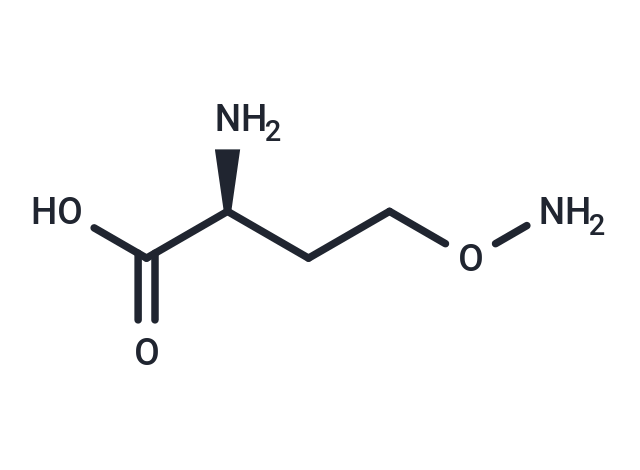Shopping Cart
- Remove All
 Your shopping cart is currently empty
Your shopping cart is currently empty

L-Canaline, a nonprotein amino acid found in many leguminous plants, exhibits potent anticancer and antiproliferative effects. It effectively inhibits the growth of the malaria parasite Plasmodium falciparum with an IC50 of 297 nM. Additionally, L-Canaline acts as a cytotoxic metabolite produced from L-canavanine through arginase catalysis and serves as a potent and irreversible inhibitor of ornithine aminotransferase.

| Pack Size | Price | Availability | Quantity |
|---|---|---|---|
| 1 mg | Inquiry | 35 days | |
| 5 mg | Inquiry | 35 days | |
| 10 mg | Inquiry | 35 days | |
| 25 mg | Inquiry | 35 days |
| Description | L-Canaline, a nonprotein amino acid found in many leguminous plants, exhibits potent anticancer and antiproliferative effects. It effectively inhibits the growth of the malaria parasite Plasmodium falciparum with an IC50 of 297 nM. Additionally, L-Canaline acts as a cytotoxic metabolite produced from L-canavanine through arginase catalysis and serves as a potent and irreversible inhibitor of ornithine aminotransferase. |
| Targets&IC50 | P. falciparum:297 nM |
| In vitro | L-Canaline is slightly less toxic to PBMCs stimulated via the mixed lymphocyte reaction (IC50 of 0.54 mM). L-canaline inhibits L-lysine flux competitively (Ki of 4.6 mM) in astrocytes and astrocytoma cells.L-Canaline treatment inhibits the proliferation of PBMCs after stimulation by phorbol 12-myristate-13-acetate (PMA) or via the mixed lymphocyte reaction.?The greatest effect is seen with PMA-stimulated cells, where L-canaline has an IC50 of 0.26 mM. |
| In vivo | Administering 100 μg of L-canaline via intraseptal injection to male Sprague-Dawley rats results in a significant 90% reduction in ornithine aminotransferase activity in septum tissues, assessed in specimens euthanized one hour post-treatment. Moreover, L-canaline lowers the aspartic acid levels in the medulla oblongata tissues of male Wistar rats, although it does not influence the stimulated release of this nonprotein amino acid into the tissues. |
| Molecular Weight | 134.13 |
| Formula | C4H10N2O3 |
| Cas No. | 496-93-5 |
| Relative Density. | 1.298g/cm3 |
| Storage | Powder: -20°C for 3 years | In solvent: -80°C for 1 year | Shipping with blue ice. |

Copyright © 2015-2025 TargetMol Chemicals Inc. All Rights Reserved.